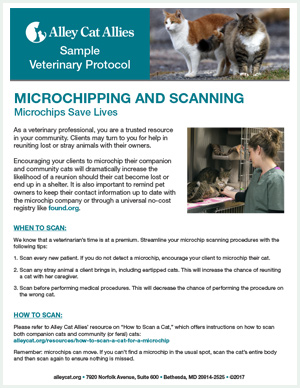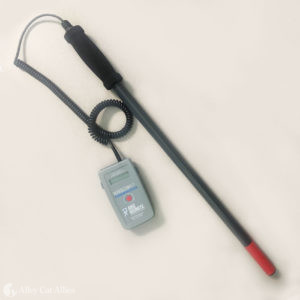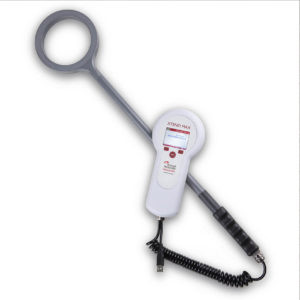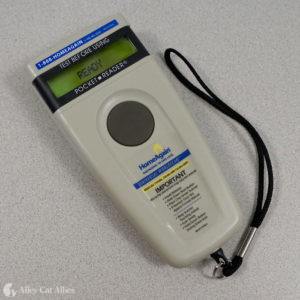As a veterinary professional, you are a trusted resource in your community. Clients may turn to you for help in reuniting lost or stray animals with their owners.
Encouraging your clients to microchip their indoor and community cats will dramatically increase the likelihood of a reunion should their cat become lost or end up in a shelter. It is also important to remind pet owners to keep their contact information up to date with the microchip company or through a universal no-cost registry like found.org.
When to scan:
We know that a veterinarian’s time is at a premium. Streamline your microchip scanning procedures with the following tips:
- Scan every new patient. If you do not detect a microchip, encourage your client to microchip their cat.
- Scan any stray animal a client brings in, including eartipped cats. This will increase the chance of reuniting a cat with her caregiver.
- Scan before performing medical procedures. This will decrease the chance of performing the procedure on the wrong cat.
How to scan:
Please refer to Alley Cat Allies’ resource on “How to Scan a Cat for a Microchip,” which offers instructions on how to scan both indoor cats and community (or feral) cats.
Remember: microchips can move. If you can’t find a microchip in the usual spot, scan the cat’s entire body and then scan again to ensure nothing is missed.
Information about scanners:
Make sure you have a universal scanner. Not all scanners and microchips are created equal. In the U.S., microchips mostly function on three frequencies: 125 kHz, 128 kHz, and 134.2 kHz.
Some scanners can only detect one of these frequencies. Ensure that your organizations or clinics have a universal scanner; a scanner that can detect all three frequencies. Without a universal scanner, you will inevitably miss some microchips.
Examples of commonly used universal scanners
- WandScan 900
- Xtend Max Scanner
- The Home Again Universal Worldscan
If a microchip is found on a stray animal:
Go to American Animal Hospital Association (AAHA) Universal Pet Microchip Lookup to see which registry the microchip is registered under. Once you’ve found the registry, call or go to its website to find contact information for the animal’s owner.
If the microchip is not registered to anyone, or if the information is not current, call the microchip manufacturer and ask to whom the microchip was sold. This can provide a starting point to tracking down an owner. Even caring people often forget to update their microchip contact information.
Note: AVID is the only major microchip provider that does not participate in AAHA microchip lookup. If you find an AVID microchip, contact the company directly.
Microchips and Trap-Neuter-Return (TNR):
Microchips aren’t just for indoor cats–they are a terrific way to track community cats!
If your clients are working with outdoor cats, encourage them to microchip every cat during the TNR process. Once the microchips are registered, each cat will have a tamper-proof identification number linked directly to their caregiver and colony location. Some microchip databases will even allow a caregiver to store medical information for quick reference. That is especially handy where community cats and vaccination records are concerned.
This simple precaution will save time, heartache, and maybe even a life if a community cat is trapped and taken to a shelter. Shelter staff will be able to easily identify the cat’s caregiver, and the cat can be returned to her outdoor home as soon as possible.
Additional Resource
Learn more about microchipping and the Plan to Scan Campaign





